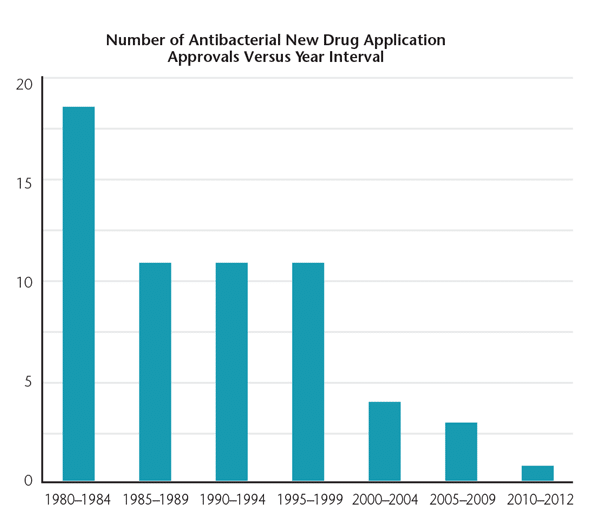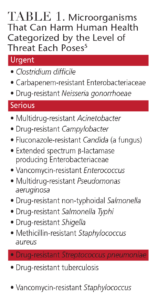
Strategies for Fighting Antibiotic Resistance
Expanding on a global scale, this threat needs to be urgently addressed across all health care fields.
As important members of the health care team, dentists must have a clear understanding of what is happening in the microbial world. Novel viruses and bacteria can emerge at any time, and may pose a risk for health care providers. The outbreak of Ebola in West Africa, which then appeared in the United States, is an example of how pathogens can impact public health.1,2
In the dental setting, it’s impossible to know which microorganisms may accompany a patient to the chair. Health histories provide self-reported pictures of patients’ current health status, but their accuracy cannot be guaranteed. A comprehensive review of patients’ health histories prior to providing treatment is critical. Patients may not report certain conditions due to the stigma attached to the problem or because they don’t think it’s important. Standard precautions should always be implemented to reduce the risk of disease transmission, and to protect dental professionals and patients.3,4
Another threat to effective infection control and the protection of health care workers is antibiotic resistance — which, according to the U.S. Centers for Disease Control and Prevention (CDC), is also known as antimicrobial resistance. The CDC reports that at least 2 million people in the U.S. are infected each year with bacteria that are resistant to antibiotics, and 23,000 die as a direct result of these infections.5 More deaths are caused by conditions related to antibiotic-resistant infections.5
Many of these antibiotic-resistant infections are spread through direct or indirect contact, putting oral health professionals at risk. Direct contact means interaction with the microorganisms at their source, such as the oral cavity or skin.5 Indirect contact occurs when a dentist is exposed to the microorganism through an intermediary item, such as a needle, instrument, piece of equipment or surface.3
In 2013, the CDC released a 114-page report, Antibiotic Resistance Threats in the United States, 2013.5 The report is organized into three sections: the threat of antibiotic resistance, fighting back against antibiotic resistance, and current antibiotic-resistant threats in the U.S.5 In order to effectively protect dental teams and patients, oral health professionals should be familiar with this report and the overall risks posed by antibiotic resistance.
![0216_antibiotic-3]() WHAT’S AT STAKE
WHAT’S AT STAKE
According to the CDC, the use of antibiotics is the single most important factor leading to antibiotic resistance around the world. Antibiotics are among the most commonly prescribed drugs in medicine, but up to 50% of these prescriptions aren’t needed.5 The report notes that humans’ exposure to antibiotics is vast, as they are commonly used in food-producing animals to promote growth and prevent, control and treat disease. Drug-resistant bacteria are present in water and animal feces, and when used on crops, their spread continues. Once individuals develop resistant bacteria, they can spread them through direct contact. Figure 1 provides more detail on how antibiotic resistance develops and spreads.5
The second section of Antibiotic Resistance Threats in the United States, 2013 focuses on four strategies to fight antibiotic resistance:
- Prevent infections from developing
- Gather data on antibiotic-resistant infections
- Promote antibiotic stewardship
- Develop new antibiotics
If infections can be prevented, the need for antibiotics decreases, which slows the pace of antibiotic resistance. The CDC is tracking the prescribing methods of health care professionals and is working to improve these protocols to reduce the use of antibiotics.5

Drugs are limited to systematic agents.
Source: U.S. Food and Drug Administration’s Center for Drug Evaluation and Research
FIGURE 2. The number of new antibiotics developed and approved has steadily
decreased over the past three decades, leaving fewer options to treat resistant
bacteria.5
To accomplish the second strategy, the CDC is gathering data on the causes of antibiotic-resistant infections and predominant risk factors. Armed with this information, researchers can develop specific strategies to prevent antibiotic-resistant infections and resistant bacteria from spreading.5
Promoting the responsible use of antibiotics — known as “antibiotic stewardship” — is the third strategy. The CDC reports that, on a global basis, health care professionals increasingly are adopting the principles of responsible antibiotic use, including prescribing antibiotics only when necessary to treat, and, in some cases, prevent disease; choosing the right antibiotics for the infection at hand; and administering them in the correct manner in every case.5 Effective stewardship ensures that each patient derives maximum benefit from antibiotics, avoids unnecessary harm from allergic reactions and side effects, and helps preserve the lifesaving potential of these drugs for the future.5
The final strategy in the battle against antibiotic resistance is the development of new antibiotics. Because antibiotic resistance is part of a natural evolution, it can be significantly slowed — but not stopped. Consequently, new antibiotics will always be needed to keep up with resistant bacteria, as well as new diagnostic tests to track the development of resistance.5 The use of antibiotics became widespread in the 1940s, and it seems logical that new drugs would be introduced each year, but this is not the case (Figure 2).5,6
SIDEBAR: Terms and Resources
Here’s a brief look at some key programs and terms that may prove useful when discussing antimicrobial resistance.
Active Bacterial Core Surveillance (ABCs): A core component of the U.S. Centers for Disease Control and Prevention’s (CDC) Emerging Infections Program (EIP) network — a collaboration between the CDC, state health departments and universities — ABCs is an active laboratoryand population-based surveillance system that tracks invasive bacterial pathogens of public health concern. It operates among 10 EIP sites across the U.S. At this time, ABCs conducts surveillance for six pathogens: group A and group B Streptococcus, Haemophilus influenzae, Neisseria meningitidis, Streptococcus pneumoniae and methicillinresistant Staphylococcus aureus.
Antimicrobial Agent: Among the antimicrobial agents in use today are antibacterial drugs, antiviral agents, antifungal agents and antiparisitic drugs.
Antimicrobial Resistance: The result of microorganisms evolving in ways that reduce or eliminate the effectiveness of drugs, chemicals or other agents used to cure or prevent infections. Antibiotic resistance is one type of antimicrobial resistance.
Emerging Infections Program (EIP): Established in 1995, the EIP is a national resource for surveillance, prevention and control of emerging infectious diseases. It’s a network of 10 state health departments and their collaborators in local health departments, academic institutions, federal agencies, and public health and clinical laboratories; the network includes infection preventionists and health care providers.
Multidrug Resistant: A term used to describe microorganisms that are resistant to multiple classes of antimicrobials. The exact number of drugs that a microorganism is resistant to varies depending on the infection or pathogen.
National Antimicrobial Resistance Monitoring System (NARMS): A collaboration among the CDC, U.S. Food and Drug Administration, U.S. Department of Agriculture, and state and local health departments, NARMS monitors antimicrobial resistance in foodborne and other enteric bacteria, including Salmonella, Campylobacter, Shigella, Escherichia coli O157, and Vibrio (non-V. cholerae).
Superinfection: An infection following a previous infection, especially when caused by microorganisms that are resistant or have become resistant to the antibiotics used previously.
Source: U.S. Centers for Disease Control and Prevention
CURRENT ANTIBIOTIC THREATS
 The final section of Antibiotic Resistance Threats in the United States, 2013 lists the current antibiotic-resistant organisms that pose a threat to human health, and categorizes them as urgent, serious or concerning (Table 1).5 The organisms that pose an urgent threat cause widespread illness and death in patients who acquire the associated infections that often become resistant to nearly all available antibiotics.5 These bacteria require immediate and aggressive action — for example, Clostridium difficile causes life-threatening diarrhea and is passed via contact transmission. Many C. difficile cases occur in patients who have been on prolonged antibiotic therapy.6
The final section of Antibiotic Resistance Threats in the United States, 2013 lists the current antibiotic-resistant organisms that pose a threat to human health, and categorizes them as urgent, serious or concerning (Table 1).5 The organisms that pose an urgent threat cause widespread illness and death in patients who acquire the associated infections that often become resistant to nearly all available antibiotics.5 These bacteria require immediate and aggressive action — for example, Clostridium difficile causes life-threatening diarrhea and is passed via contact transmission. Many C. difficile cases occur in patients who have been on prolonged antibiotic therapy.6
Microorganisms characterized as a serious threat necessitate prompt and sustained attention to keep the risks they pose from growing. The label of concerning threat means that the microorganisms need careful monitoring and preventive action to ensure they don’t move into the higher threat levels. The report provides a wealth of information on each of the bacteria included within all three threat categories, including how health care professionals can support the CDC’s efforts to reduce the threat posed by these microorganisms.
Oral health care providers need to be aware of antibiotic-resistant organisms and how they can support the battle against them. By keeping up to date and adopting the CDC’s strategies to reduce antibiotic resistance, clinicians can protect their team’s health, as well as the health of patients.
key takeaways
- The U.S. Centers for Disease Control and Prevention (CDC) estimates that each year 23,000 American die as direct result of antibiotic-resistant infections.5
- Patients may not report certain conditions due to the stigma attached to the problem or because they don’t think it’s important; consequently, standard infection prevention precautions should always be followed to reduce the risk of disease transmission.
- Many antibiotic-resistant infections are spread through direct or indirect contact, putting oral health professionals at risk.
- The core logic behind the fight against antimicrobial resistance is that if infections can be prevented, the need for antibiotics decreases — which slows the pace of resistance.
- Dental professionals are encouraged to adopt the principles of antibiotic stewardship to help preserve the lifesaving potential of these drugs for the future.5
- By keeping up to date and supporting the CDC’s strategies to reduce antibiotic resistance, clinicians can help protect providers’ and patients’ health.
References
- World Health Organization. Ebola Virus Disease. Available at: who.int/mediacentre/factsheets/fs103/en. Accessed January 13, 2016.
- McCoy CE, Lotfipour S, Chakravarthy B, Schultz C, Barton E. Emergency medical services public health implications and interim guidance for the Ebola virus in the United States. West J Emerg Med. 2014;15:723–727.
- Miller CH. Infection Control and Management of Hazardous Materials for the Dental Team. 5th ed. St. Louis: Mosby Elsevier; 2014:19–21.
- Kohn WG, Collins AS, Cleveland JL, et al. Guidelines for infection control in dental health-care settings—2003. MMWR Recomm Rep. 2003;52:1–61.
- U.S. Centers for Disease Control and Prevention. Antibiotic/Antimicrobial Resistance; Antibiotic Resistance Threats in the United States, 2013. Available at: cdc.gov/drugresistance/threat-report-2013. Accessed January 13, 2016.
- U.S. Centers for Disease Control and Prevention. Get Smart: Know When Antibiotics Work. Available at: cdc.gov/getsmart/antibiotic-use/antibiotic-resistance-faqs.html. Accessed January 13, 2016.



